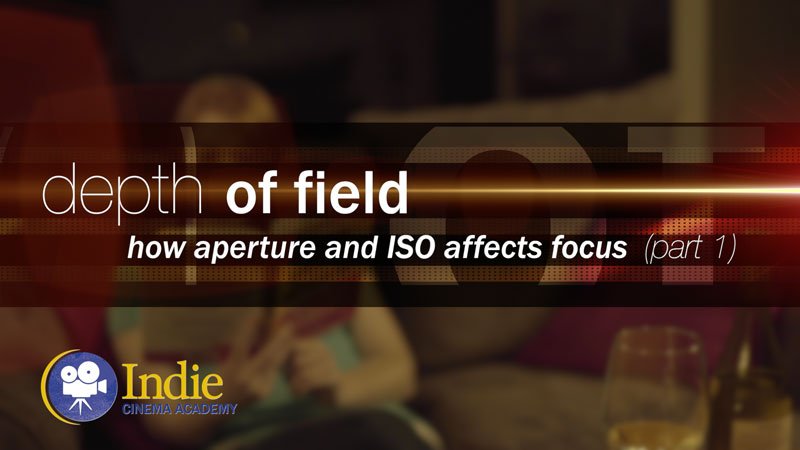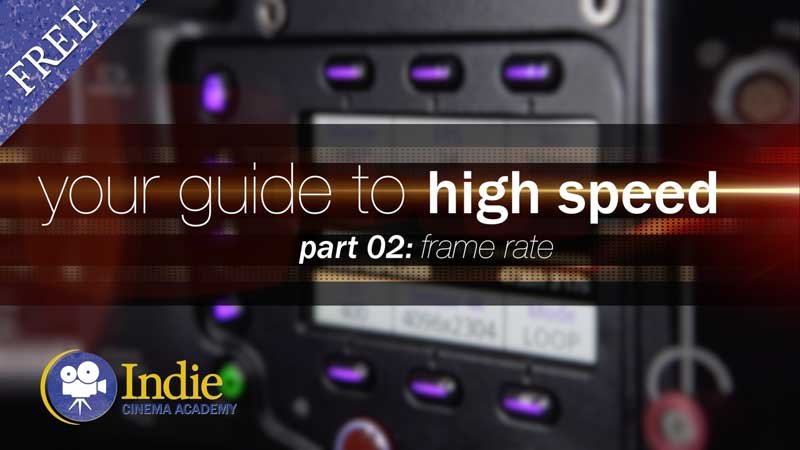Advanced Exposure: Raw and Log (Camera Lesson 33)
Summary: Camera RAW and log settings throw additional considerations into the mix when it comes to exposing your film image properly. In this video Ryan shares what those considerations are and how they impact exposure choices for your film production.
Length: 6:53 minutes
!! Want to see the whole video? Become a member !!
- If you are already a member, you can log in below.
Introduction
If things were not complicated enough already when it comes to exposing your image, along comes RAW & log to throw another wrench into the system. And that is why in this video I’m going to help you better understand how to get proper exposure when using a camera that shoots in RAW or in log.
Log
Remember everything I taught you about IRE values and where things should fall on the waveform monitor? Well when it comes to shooting with a camera that records in log, you have to throw all that information out the window. And the reason why is because when camera manufactures use log values to record the images, they end up remapping tone values to different IRE values. And to complicate the matter more, each manufacture does it a bit differently. For example, Canon has decided to map their mid-tone value to 33 IRE, and Sony has decided to map their mid tone value to 38 IRE. So I can’t give you one rule that will work for all cameras. Which is why you have to end up reading the white papers that get published by different camera manufactures, or you have to do your own testing if those numbers are not published.
But lets take a look at one example so that you can see what is going on here. I am going to use Canon’s C-log as the example here.…
** Want to read the rest of the transcript? Become a member. **
 https://indiecinemaacademy.com/wp-content/uploads/2016/10/ICA_DoF01_How_Aperture_and_ISO_Affects_Focus-Thumbnail-web.jpg
450
800
Tim
https://indiecinemaacademy.com/wp-content/uploads/2013/12/Indie_cinema_Logo_2color-MF-300x116-web.png
Tim2016-10-10 00:15:202025-03-11 14:46:47Depth of Field, Part 1: How Aperture and ISO Affect Focus
https://indiecinemaacademy.com/wp-content/uploads/2016/10/ICA_DoF01_How_Aperture_and_ISO_Affects_Focus-Thumbnail-web.jpg
450
800
Tim
https://indiecinemaacademy.com/wp-content/uploads/2013/12/Indie_cinema_Logo_2color-MF-300x116-web.png
Tim2016-10-10 00:15:202025-03-11 14:46:47Depth of Field, Part 1: How Aperture and ISO Affect Focus https://indiecinemaacademy.com/wp-content/uploads/2015/12/CS006-HighSpeed-Part06-FREE-Thumbnail-Web.jpg
450
800
Ryan E. Walters
https://indiecinemaacademy.com/wp-content/uploads/2013/12/Indie_cinema_Logo_2color-MF-300x116-web.png
Ryan E. Walters2015-12-14 00:15:052015-12-29 13:20:06Your Guide To High Speed, Part 6: Five Tips For A Successful Shoot
https://indiecinemaacademy.com/wp-content/uploads/2015/12/CS006-HighSpeed-Part06-FREE-Thumbnail-Web.jpg
450
800
Ryan E. Walters
https://indiecinemaacademy.com/wp-content/uploads/2013/12/Indie_cinema_Logo_2color-MF-300x116-web.png
Ryan E. Walters2015-12-14 00:15:052015-12-29 13:20:06Your Guide To High Speed, Part 6: Five Tips For A Successful Shoot https://indiecinemaacademy.com/wp-content/uploads/2015/12/CS005-HighSpeed-Part05-FREE-Thumbnail-Web.jpg
450
800
Ryan E. Walters
https://indiecinemaacademy.com/wp-content/uploads/2013/12/Indie_cinema_Logo_2color-MF-300x116-web.png
Ryan E. Walters2015-11-30 09:00:282015-12-29 15:41:16Your Guide To High Speed, Part 5: Lighting Six High Speed Sets
https://indiecinemaacademy.com/wp-content/uploads/2015/12/CS005-HighSpeed-Part05-FREE-Thumbnail-Web.jpg
450
800
Ryan E. Walters
https://indiecinemaacademy.com/wp-content/uploads/2013/12/Indie_cinema_Logo_2color-MF-300x116-web.png
Ryan E. Walters2015-11-30 09:00:282015-12-29 15:41:16Your Guide To High Speed, Part 5: Lighting Six High Speed Sets https://indiecinemaacademy.com/wp-content/uploads/2015/12/CS004-HighSpeed-Part04-FREE-Thumbnail-Web.jpg
450
800
Ryan E. Walters
https://indiecinemaacademy.com/wp-content/uploads/2013/12/Indie_cinema_Logo_2color-MF-300x116-web.png
Ryan E. Walters2015-11-16 00:15:182015-12-29 13:17:26Your Guide To High Speed, Part 4: Common Lighting Problems
https://indiecinemaacademy.com/wp-content/uploads/2015/12/CS004-HighSpeed-Part04-FREE-Thumbnail-Web.jpg
450
800
Ryan E. Walters
https://indiecinemaacademy.com/wp-content/uploads/2013/12/Indie_cinema_Logo_2color-MF-300x116-web.png
Ryan E. Walters2015-11-16 00:15:182015-12-29 13:17:26Your Guide To High Speed, Part 4: Common Lighting Problems https://indiecinemaacademy.com/wp-content/uploads/2015/12/CS003-HighSpeed-Part03-FREE-Thumbnail-Web.jpg
450
800
Ryan E. Walters
https://indiecinemaacademy.com/wp-content/uploads/2013/12/Indie_cinema_Logo_2color-MF-300x116-web.png
Ryan E. Walters2015-11-02 00:15:272015-12-29 13:15:49Your Guide To High Speed, Part 3: Camera Operation & Workflow
https://indiecinemaacademy.com/wp-content/uploads/2015/12/CS003-HighSpeed-Part03-FREE-Thumbnail-Web.jpg
450
800
Ryan E. Walters
https://indiecinemaacademy.com/wp-content/uploads/2013/12/Indie_cinema_Logo_2color-MF-300x116-web.png
Ryan E. Walters2015-11-02 00:15:272015-12-29 13:15:49Your Guide To High Speed, Part 3: Camera Operation & Workflow https://indiecinemaacademy.com/wp-content/uploads/2015/12/CS002-HighSpeed-Part02-FREE-Thumbnail-Web.jpg
450
800
Ryan E. Walters
https://indiecinemaacademy.com/wp-content/uploads/2013/12/Indie_cinema_Logo_2color-MF-300x116-web.png
Ryan E. Walters2015-10-19 12:25:282015-12-29 15:21:30Your Guide To High Speed, Part 2: Frame Rate
https://indiecinemaacademy.com/wp-content/uploads/2015/12/CS002-HighSpeed-Part02-FREE-Thumbnail-Web.jpg
450
800
Ryan E. Walters
https://indiecinemaacademy.com/wp-content/uploads/2013/12/Indie_cinema_Logo_2color-MF-300x116-web.png
Ryan E. Walters2015-10-19 12:25:282015-12-29 15:21:30Your Guide To High Speed, Part 2: Frame Rate https://indiecinemaacademy.com/wp-content/uploads/2015/12/CS001-HighSpeed-Part01-FREE-Thumbnail-Web.jpg
450
800
Ryan E. Walters
https://indiecinemaacademy.com/wp-content/uploads/2013/12/Indie_cinema_Logo_2color-MF-300x116-web.png
Ryan E. Walters2015-10-05 00:15:592015-12-29 13:20:38Your Guide To High Speed, Part 1: Introduction
https://indiecinemaacademy.com/wp-content/uploads/2015/12/CS001-HighSpeed-Part01-FREE-Thumbnail-Web.jpg
450
800
Ryan E. Walters
https://indiecinemaacademy.com/wp-content/uploads/2013/12/Indie_cinema_Logo_2color-MF-300x116-web.png
Ryan E. Walters2015-10-05 00:15:592015-12-29 13:20:38Your Guide To High Speed, Part 1: Introduction https://indiecinemaacademy.com/wp-content/uploads/2015/09/LC115_12Questions-Thumbnail-Free-Web.jpg
450
800
Ryan E. Walters
https://indiecinemaacademy.com/wp-content/uploads/2013/12/Indie_cinema_Logo_2color-MF-300x116-web.png
Ryan E. Walters2015-09-07 00:30:532015-10-30 19:06:3612 Crucial Questions To Ask Before You Light Your Set (Cinematic Lighting Lesson 15)
https://indiecinemaacademy.com/wp-content/uploads/2015/09/LC115_12Questions-Thumbnail-Free-Web.jpg
450
800
Ryan E. Walters
https://indiecinemaacademy.com/wp-content/uploads/2013/12/Indie_cinema_Logo_2color-MF-300x116-web.png
Ryan E. Walters2015-09-07 00:30:532015-10-30 19:06:3612 Crucial Questions To Ask Before You Light Your Set (Cinematic Lighting Lesson 15) https://indiecinemaacademy.com/wp-content/uploads/2015/03/LC108-NegativeFill-Thumbnail-Web.jpg
450
800
Ryan E. Walters
https://indiecinemaacademy.com/wp-content/uploads/2013/12/Indie_cinema_Logo_2color-MF-300x116-web.png
Ryan E. Walters2015-03-23 00:30:392015-10-30 18:34:25Negative Fill: The Best Kept Secret (Cinematic Lighting Lesson 08)
https://indiecinemaacademy.com/wp-content/uploads/2015/03/LC108-NegativeFill-Thumbnail-Web.jpg
450
800
Ryan E. Walters
https://indiecinemaacademy.com/wp-content/uploads/2013/12/Indie_cinema_Logo_2color-MF-300x116-web.png
Ryan E. Walters2015-03-23 00:30:392015-10-30 18:34:25Negative Fill: The Best Kept Secret (Cinematic Lighting Lesson 08)Leave a Reply
Want to join the discussion?Feel free to contribute!
Leave a Reply Cancel reply
You must be logged in to post a comment.
This site uses Akismet to reduce spam. Learn how your comment data is processed.

How about Black Magic? I believe they show you in the camera monitoring, when you choose “Film DR” (even when shooting Log ProRes), only what the RAW sensor is seeing… So, does this mean that if I am choosing my EI depending on how much detail I need on Highlights or Shadows only apply to raw and its wrong for Log? Or does the DR get distributed too there?
And what have you tested as being the middle in BMCC 2.5K? It would be great if you could show a demo of the DR distribution vs EI in your tests!!! And more so on these manufacturers that do not share much native information (Optimal ISO, Bit Depth RAW vs Log, and namely Color Temp that can affect things quite a bit too no?…) Hahaha, I want it all… Sorry
And here is where things can get confusing, it all depend on the camera manufacture. With Blackmagic, the camera can record in both RAW (DNG) and log (ProRes), but when it records in log (ProRes) using “Film DR” it is pulling the info straight from the sensor just like it would for the RAW data. So if the DR of that camera has less detail in the highlights at some EI’s than at others, then that will be true for the log file as well. And that is NOT the case for other cameras like Canon – once you go above their “optimal / native” ISO (which is 850) the highlight detail (latitude) stays the same. So it is all about knowing your camera system, and how it responds.
For the Blackmagic Cinema Camera (BMCC) 2.5k when you are at ISO 800, that seems to be a good place to be at for an even distribution of the DR. It has about 5 stops over and about 5 stops under. (Maybe a bit more under- up to 7 under depending on how noise tolerant you are.)
Thanks for the ideas / recommendation on showing the DR distribution vs EI, optimal ISO, RAW vs Log, etc. I’ll add that to the list of training to release. 🙂
You mentioned 2% black, what does the 2% refer to?
On the diagram 1:57 in there was a part about mid tones being 33%. Is this your way of saying the exposure falls at 33 IRE?
These percentages are referencing the Zone System, which we discuss in Lesson 32. The 2% refers to the amount of light reflecting off a Zone 1 surface. At 2% reflectance and below, it is considered “pure black.”
Yes, 33% is referring to 33 IRE.
I like to use LUTs on my camera when shoting in log , will this effect the reading of IRE ?
Yes, it will affect the IRE shown on your waveform.
Thank you
But 2 more questions plz
What dose (native ISO ) mean ?
Is it right that it means to put the latitude in the middle I mean the highlite information equal the shadow info
Is that true?
Native ISO is the ISO that sensor performs the best at. When using film, this would be the ISO of the film. For those who have used film, you know that you can “push” the film to be a different ISO, but often that results in more grain. Same with digital sensors: when you are setting your camera to a non-native ISO, the camera is actually changing the gain on the digital signal. This too adds a bit of noise and can decrease the dynamic range of the sensor.
The “latitude” (or “middle gray”) is often close to the middle of the range, however rarely is it exactly in the middle. The sensor often can “see” more stops in the shadows than in the highlights. The same is true for our eyes which is why “middle gray” is at 18% Gray and not 50% Gray. It’s because the intensity of light grows exponentially since it is doubling with every stop. It’s also why highlights clip so fast. This all means that you may adjust where you put middle gray based on the dynamic range of your scene. If you have a lot of important highlights and shadows you have to be much more careful where you put middle gray than if your scene is lower contrast. In lower contrast scenes, you may adjust middle gray so that you save your highlights or save your shadows.
Hi,
In Lesson 11 you state that when shooting in RAW, all camera data except aperture and shutter speed is recorded as metadata. So ISO is adjustable in post, and not something “baked” into the image. It seems to me that what you are saying here regarding ISO adjusting the mid-tone level contradicts that. Can you help clarify? Thanks.
There are two answers to this depending on what camera you are using. The first answer is for all cameras other than RED. With these other cameras, there is some analog processing on the data coming off the sensor prior to the analog-digital conversion and final RAW recording. The ISO setting affects this analog processing, so it does affect the final image even though it is still RAW. The mid-tones will be the same, but the dynamic range changes as does the graininess of the image. With RED cameras, they truly are recording everything off the sensor and so ISO is not baked in. However, when the ISO is adjusted in post-production, the placement of middle gray changes along the dynamic range, which changes mid-tone levels. RED has a very thorough article discussing ISO’s affect on middle gray within RAW.